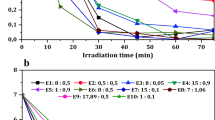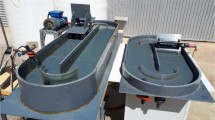Abstract
This study evaluated, at laboratory scale, if the using iron naturally present (0.3 mg L−1) and adding 10 mg L−1 of hydrogen peroxide was effective to remove 24.3 mgL−1 of 2,4-dichlorophenoxyacetic acid (2,4-D) from groundwater samples by simulated solar irradiation (global intensity = 300 W m−2). Under these conditions, the degradation of 2,4-D reached 75.2 % and the apparition of its main oxidation byproduct 2,4-dichlorophenol (DCP) was observed. On the other hand, pH exhibited an increasing from 7.0 to 8.3 during the experiment. Experiments using Milli-Q water at pH 7.0, iron, and H2O2 concentrations of 0.3 and 10 mg L−1, respectively, were carried out in order to study the effect of ions such as carbonate species, phosphate, and fluoride in typical concentrations often found in groundwater. Ion concentrations were combined by using a factorial experimental design 23. Results showed that carbonates and fluoride did not produce a detrimental effect on the 2,4-D degradation, while phosphate inhibited the process. In this case, the pH increased also from 7.0 to 7.95 and 8.99. Effect of parameters such as pH, iron concentration, and hydrogen peroxide concentration on the 2,4-D degradation by the photo-Fenton process in groundwater was evaluated by using a factorial experimental design 23. Results showed that the pH was the main parameter affecting the process. This study shows for the first time that using the photo-Fenton process at circumneutral pH and iron naturally present seems to be a promising process to remove pesticides from groundwater.







Similar content being viewed by others
References
Appelo CAJ, Postma D (2005) Geochemistry, groundwater and pollution. A.A. Balkema Publishers, Amsterdam
AWWA, APHA, WEF (2012) Standard methods for the examination of water and waste water, Ed. 22 edn. APHA, Washington
Baltazar MT, Dinis-Oliveira RJ, de Lourdes Bastos M, Tsatsakis AM, Duarte JA, Carvalho F (2014) Pesticides exposure as etiological factors of Parkinson’s disease and other neurodegenerative diseases—a mechanistic approach. Toxicol Lett 230:85–103. doi:10.1016/j.toxlet.2014.01.039
Bernabeu A, Palacios S, Vicente R, Vercher RF, Malato S, Arques A, Amat AM (2012) Solar photo-Fenton at mild conditions to treat a mixture of six emerging pollutants. Chem Eng J 198-199:65–72. doi:10.1016/j.cej.2012.05.056
Bokare AD, Choi W (2014) Review of iron-free Fenton-like systems for activating H2O2 in advanced oxidation processes. J Hazard Mater 275:121–135. doi:10.1016/j.jhazmat.2014.04.054
Cawley KM, Hakala JA, Chin Y-P (2009) Evaluating the triplet state photoreactivity of dissolved organic matter isolated by chromatography and ultrafiltration using an alkylphenol probe molecule. Limnol Oceanogr Methods 7:391–398. doi:10.4319/lom.2009.7.391
Cheng Z, Li Y (2007) What is responsible for the initiating chemistry of iron-mediated lipid peroxidation: an update. Chem Rev 107:748–766. doi:10.1021/cr040077w
Conte LO, Farias J, Albizzati ED, Alfano OM (2012) Photo-Fenton degradation of the herbicide 2,4-dichlorophenoxyacetic acid in laboratory and solar pilot-plant reactors. Ind Eng Chem Res 51:4181–4191. doi:10.1021/ie2023228
De Laurentiis E, Minella M, Maurino V, Minero C, Vione D (2014) Effect of climate change on surface-water photochemistry. A review. Environ Sci Pollut Res 21:11770–11780. doi:10.1007/s11356-013-2343-0
Dell’Arciprete ML, Soler JM, Santos-Juanes L, Arques A, Martire DO (2013) Reactivity of neonicotinoid insecticides with carbonate radicals. Water Res 46:3479–3489. doi:10.1016/j.watres.2012.03.051
Devi LG, Raju KSA, Kumar SG, Rajashekhar KE (2011) Photo-degradation of di azo dye Bismarck Brown by advanced photo-Fenton process: influence of inorganic anions and evaluation of recycling efficiency of iron powder. J Taiwan Inst Chem Eng 42:341–349. doi:10.1016/j.jtice.2010.05.010
Du W, Xu Y, Wang Y (2008) Photoinduced degradation of orange II on different iron (hydr)oxides in aqueous suspension: rate enhancement on addition of hydrogen peroxide, silver nitrate, and sodium fluoride. Langmuir 24:175–181. doi:10.1021/la7021165
Fenton HJH (1894) Oxidation of tartaric acid in presence of iron. J Chem Soc 65:899–910
Gligorovski S, Strekowski R, Barbati S, Vione D (2015) Environmental implications of hydroxyl radicals (·OH). Chem Rev 115:13051–13092. doi:10.1021/cr500310b
Haber F, Weiss J (1934) The catalytic decomposition of hydrogen peroxide by iron salts. Proc Roy Soc A 134:332–351
Karci A, Arslan-Alaton I, Olmez-Hanci T, Bekbölet M (2012) Transformation of 2,4-dichlorophenol by H2O2/UV-C, Fenton and photo-Fenton processes: oxidation products and toxicity evolution. J Photochem Photobiol A 230:65–73. doi:10.1016/j.jphotochem.2012.01.003
King D, Farlow R (2000) Role of carbonate speciation on the oxidation of Fe (II) by H2O2. Mar Chem 70:201–209. doi:10.1016/S0304-4203(00)00026-8
Klamerth N, Malato S, Aguera A, Fernández-Alba A (2013) Photo-Fenton and modified photo-Fenton at neutral pH for the treatment of emerging contaminants in wastewater treatment plant effluents: a comparison. Water Res 47:833–840. doi:10.1016/j.watres.2012.11.008
Luna AJ, Chiavone-Filho O, Machulek A, de Moraes JEF, Nascimento CAO (2012) Photo-Fenton oxidation of phenol and organochlorides (2,4-DCP and 2,4-D) in aqueous alkaline medium with high chloride concentration. J Environ Manag 111:10–17. doi:10.1016/j.jenvman.2012.06.014
Lipczynska-Kochany E, Sprah G, Harms S (1995) Influence of some groundwater and surface waters constituents on the degradation of 4-chlorophenol by the Fenton reaction. Chemosphere 30:9–20. doi:10.1016/0045-6535(94)00371-Z
Lipczynska-kochany E, Kochany J (2008) Effect of humic substances on the Fenton treatment of wastewater at acidic and neutral pH. Chemosphere 73:745–750. doi:10.1016/j.chemosphere.2008.06.028
Miller CJ, Vincent Lee SM, Rose AL, Waite TD (2012) Impact of natural organic matter on H2O2-mediated oxidation of Fe(II) in coastal seawaters. Environ Sci Technol 46:11078–11085. doi:10.1021/es3022792
Nakatani N, Ueda M, Shindo H, Takeda K, Sakugawa H (2007) Contribution of the photo-Fenton reaction to hydroxyl radical formation rates in river and rainwater samples. Anal Sci 23:1137–1142. doi:10.2116/analsci.23.1137
Ndounla J, Spuhler D, Kenfack S, Wéthé J, Pulgarin C (2013) Inactivation by solar photo-Fenton in pet bottles of wild enteric bacteria of natural well water: absence of re-growth after one week of subsequent storage. Appl Catal B Environ 129:309–317. doi:10.1016/j.apcatb.2012.09.016
Ndounla J, Kenfack S, Wéthé J, Pulgarin C (2014) Relevant impact of irradiance (vs. dose) and evolution of pH and mineral nitrogen compounds during natural water disinfection by photo-Fenton in solar CPC reactor. Appl Catal B Environ 148–149:144–153. doi:10.1016/j.apcatb.2013.10.048
Pignatello JJ, Oliveros E, MacKay A (2006) Advanced oxidation process for organic contaminant destruction based on the Fenton reaction and related chemistry. Crit Rev Environ Sci Technol 36:1–84. doi:10.1080/10643380500326564
Ruales-Lonfat C, Benítez N, Sienkiewicz A, Pulgarín C (2014) Deleterious effect of homogeneous and heterogeneous near-neutral photo-Fenton system on Escherichia coli. Comparison with photo-catalytic action of TiO2 during cell envelope disruption. Appl Catal B Environ 160-161:286–297. doi:10.1016/j.apcatb.2014.05.001
Ramamoorthy S, Ramamoorthy R (1997) Chlorinated organic compounds in the environment. Regulatory and monitoring assessment. Lewis Publishers, Boca Raton
Ruales-Lonfat C, Barona JF, Sienkiewicz A, Bensimon M, Vélez-Colmenares J, Benítez N, Pulgarín C (2015) Iron oxides semiconductors are efficients for solar water disinfection: a comparison with photo-Fenton processes at neutral pH. Appl Catal B Environ 166-167:497–508. doi:10.1016/j.apcatb.2014.12.007
Schenone AV, Conte LO, Botta MA, Alfano OM (2015) Modeling and optimization of photo-Fenton degradation of 2,4-D using ferrioxalate complex and response surface methodology (RSM). J Environ Manag. doi:10.1016/j.jenvman.2015.03.028
Sciacca F, Rengifo–Herrera J, Wethe J, Pulgrarín C (2010) Dramatic enhancement of solar disinfection (SODIS) of wild Salmonella sp. in PET bottles by H2O2 addition on natural water of Burkina Faso containing dissolved iron. Chemosphere 78:1186–1191. doi:10.1016/j.chemosphere.2009.12.001
Sciacca F, Rengifo–Herrera J, Wethe J, Pulgarin C (2011) Solar disinfection of wild Salmonella sp. in natural water with a 18 LCPC photoreactor: detrimental effect of non-sterile storage of treated water. Sol Energy 85:1399–1408. doi:10.1016/j.solener.2011.03.022
Spuhler D, Rengifo-Herrera JA, Pulgarin C (2010) The effect of Fe2+ ,Fe3+, H2O2 and the photo-Fenton reagent at near neutral pH on the solar disinfection (SODIS) at low temperatures of water containing Escherichia coli K12. Appl Catal B Environ 96:126–141. doi:10.1016/j.apcatb.2010.02.010
Soler J, García-Ripoll A, Hayek N, Miró P, Vicente R, Arques A, Amat AM (2009) Effect of inorganic ions on the solar detoxification of water polluted with pesticides. Water Res 43:4441–4450. doi:10.1016/j.watres.2009.07.011
Thornton P, Herrero M (2010) The inter-linkages between rapid growth in livestock production, climate change, and the impacts on water resources, land use, and deforestation. Policy Research Working Paper Series, Vol (2010)
United States Environmental Protection Agency (2011) Pesticides industry sales and usage: 2006 and 2007 market estimates. IOP Publishing PhysicsWeb. http://nepis.epa.gov/Adobe/PDF/3000659P.pdf. Accessed 28 Nov 2015
Vermilyea AW, Voelker BM (2009) Photo-Fenton reaction at near neutral pH. Environ Sci Technol 43:6927–6933. doi:10.1021/es900721x
Acknowledgments
The authors thank the “Corporación Autónoma Regional del Valle del Cauca” (CVC) for its support and advising about the sampling of groundwater and Alejandra Correa and Bryan Munera for their collaboration in the laboratory. The authors are especially grateful to the Universidad del Valle for the economic support (Project SICOP- 2761). J.A. Rengifo-Herrera is grateful with the National Scientific and Technical Research Council (CONICET)-Argentina (Resolución 3646/14) and the National University of La Plata (Project X-603) for their economical and institutional support.
Author information
Authors and Affiliations
Corresponding authors
Ethics declarations
Conflict of interest
The authors declare that they have no conflict of interest.
Additional information
Responsible editor: Philippe Garrigues
Rights and permissions
About this article
Cite this article
Gutiérrez-Zapata, H.M., Rojas, K.L., Sanabria, J. et al. 2,4-D abatement from groundwater samples by photo-Fenton processes at circumneutral pH using naturally iron present. Effect of inorganic ions. Environ Sci Pollut Res 24, 6213–6221 (2017). https://doi.org/10.1007/s11356-016-7067-5
Received:
Accepted:
Published:
Issue Date:
DOI: https://doi.org/10.1007/s11356-016-7067-5




